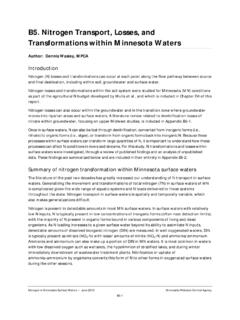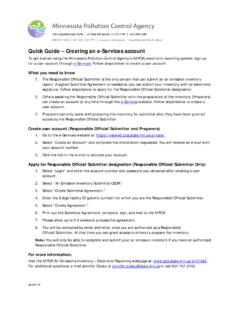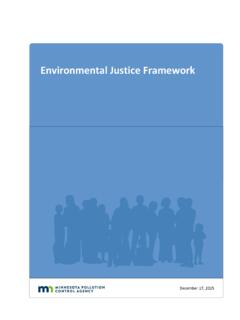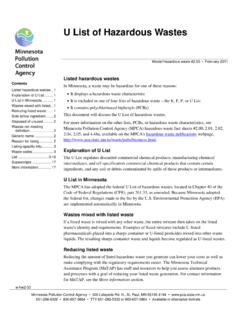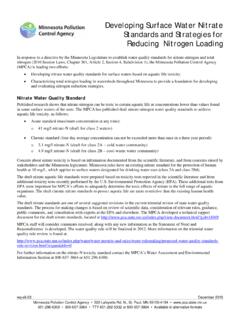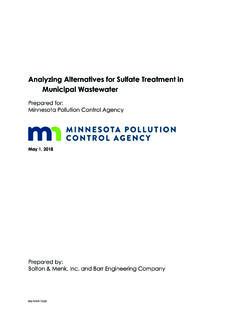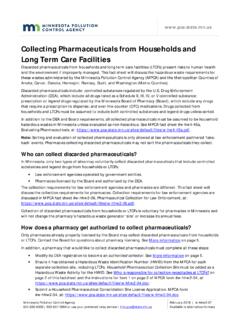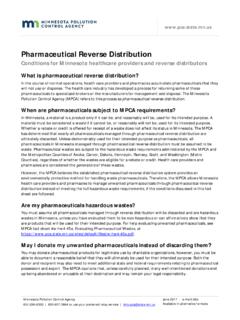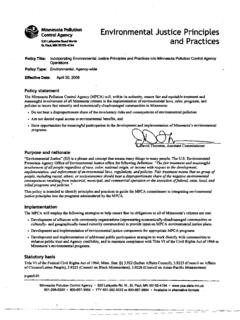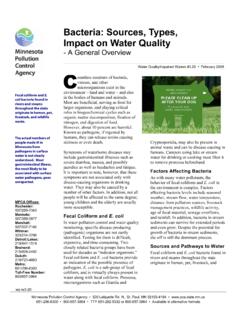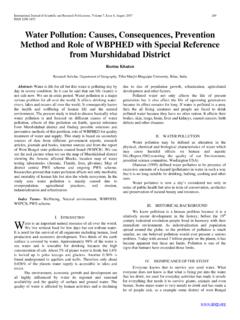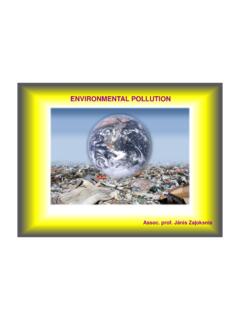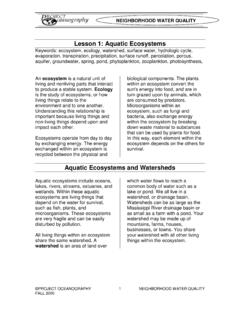Transcription of Nutrients: Phosphorus, Nitrogen Sources, Impact on Water ...
1 Nutrients: Phosphorus, Nitrogen Sources, Impact on Water Quality - A General Overview Water Quality/Impaired Waters # May 2008 minnesota pollution control agency 520 Lafayette Rd. N., St. Paul, MN 55155-4194 651-296-6300 800-657-3864 TTY 651-282-5332 or 800-657-3864 Available in alternative formats wq-iw3-22 MPCA Area Offices: Rochester area: 507/285-7343 Mankato area: 507/389-5977 Marshall area: 507/537-7146 Willmar area: 320/214-3786 Detroit Lakes area: 218/847-1519 Brainerd area: 218/828-2492 Duluth area: 218/723-4660 Metro area: 651/296-6300 Toll-Free Number: 800/657-3864 All lakes need protection from the pollution that robs them of oxygen and aquatic life.
2 We can't do anything about nutrients from natural sources and the sun s warmth, but we can work to prevent excessive nutrients and sediments from human activity from getting into lakes and waterways. Photo: Grace Lake, Beltrami County SWCD n the 1997 Clean Water Action Plan the Environmental Protection agency identified nutrients as a significant national problem contributing to Water pollution . states reported that more than half of all lakes were affected. Just as applying fertilizer to gardens and farm fields helps crops grow, nutrients entering lakes and rivers feed the growth of algae, bacteria, and other tiny organisms.
3 Water bodies require some nutrients to be healthy, but too much can be harmful. When lakes receive an overabundance of nutrients, they can become polluted by excessive amounts of algae. Die-off and decomposition of algae blooms can reduce dissolved oxygen and suffocate fish and other aquatic life. Some forms of algae (blue-green) may produce toxins that can be harmful if ingested by humans and animals. Phosphorus and Nitrogen Phosphorus (P) and Nitrogen (N) are the primary nutrients that in excessive amounts pollute our lakes, streams, and wetlands. Nitrogen is essential to the production of plant and animal tissue.
4 It is used primarily by plants and animals to synthesize protein. Nitrogen enters the ecosystem in several chemical forms and also occurs in other dissolved or particulate forms, such as tissues of living and dead organisms. Nitrate, a compound containing Nitrogen , can exist in the atmosphere or as a dissolved gas in Water , and at elevated levels can have harmful effects on humans and animals. Nitrates in Water can cause severe illness in infants and domestic animals. Common sources of excess nitrate reaching lakes and streams include septic systems, animal feed lots, agricultural fertilizers, manure, industrial waste waters, sanitary landfills, and garbage dumps.
5 Phosphorus Fuels Algae Growth Phosphorus is a vital nutrient for converting sunlight into usable energy, and essential to cellular growth and reproduction. It is one of the 20 most abundant elements in the solar system, and the 11th most abundant in the earth s crust. Under natural conditions phosphorus is typically scarce in Water . In the late 1960s scientists discovered phosphorus contributed by human activity to be a major cause of excessive algae growth and degraded lake Water quality. Phosphorus occurs in dissolved organic and inorganic forms or attached to sediment particles.
6 Phosphates, the inorganic form, are preferred for plant growth, but other forms can be used when phosphates are unavailable. Phosphorus builds up in the sediments of a lake. When it remains in the sediments it is generally not available for use by algae; however, various chemical and biological processes can allow sediment phosphorus to be released back into the Water . For example, I Phosphorus, Nitrogen Impact on Water Quality Water Quality/Impaired Waters # May 2008 page 2 Trophic State Index TSI: Higher number greater nutrient enrichment and lower Water clarity (Secchi disk transparency or SDT) bottom-feeding rough fish such as carp can stir up bottom sediments, releasing phosphorus back into the Water .
7 Impact on Water Quality Citizen volunteers use Secchi disks to collect data on Water clarity. Poor Water quality in lakes can have many unpleasant consequences. Rough fish such as carp and bullhead populations increase at the expense of game fish populations. Severe nuisance algal blooms yield unpleasant odor and appearance that reduce the aesthetic appeal of lakes. This may result in declines in fishing and swimming and hurt tourism. As algae die and decompose, the process consumes oxygen. Submerged plants without sunlight die, decompose and consume more oxygen.
8 Without enough dissolved oxygen in the Water , fish and other organisms suffer and die because they can't breathe. This can occur locally or much farther downstream leading to degraded estuaries, lakes and reservoirs. For example, fish and other aquatic life can no longer survive in the so-called dead zone in the Gulf of Mexico. Nutrient Sources and Pathways The geology and land use within a lake s watershed determine the amount of nutrients that enter the lake via surface Water runoff . Eutrophication is the slow aging process during which a lake, estuary, or bay evolves into a bog or marsh and eventually disappears.
9 Some of the nutrients come from natural processes, such as decomposition of plant and animal material. During the later stages of eutrophication the Water body is choked by abundant plant life due to higher levels of nutrients such as Nitrogen and phosphorus. Human activities can accelerate the process with urban construction, sewage discharges, agricultural practices, and residential development. Measuring Impact of Nutrients Not all lakes are affected to the same degree. The green yuck permeates shallow lakes in the south more so than deeper, cooler northern lakes.
10 The MPCA uses ecoregion-based total phosphorus guidelines in conjunction with Carlson s Trophic State Index (see chart) to classify lakes in their level of quality for swimming and fishing. TSI is a numeric index of lake trophic status on a scale of 1 to 100, the higher the number indicating greater nutrient enrichment. Lake nutrient standards that vary according to ecoregion and lake type have recently been developed. These Water quality standards will provide a basis for determining the impairment status of minnesota s lakes and will be useful for protecting the quality of good lakes as well.
